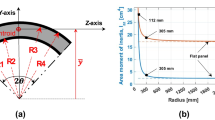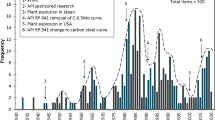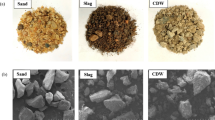Abstract
Fatigue life tests in pressurized water reactor (PWR) environments were performed on smooth and sharply notched specimens of ASME SA-106-B piping steel at cyclic frequencies of 1.0 Hz, 0.1 Hz, and 0.017 Hz. On the basis of these tests, it was concluded that no effect of cyclic frequency existed for smooth specimens whereas a frequency of 0.017 Hz proved to have the most detrimental effect on the cyclic life of the notched specimens. However, a reduction in fatigue strength in the low cycle fatigue regime and a fatigue strength enhancement in the high cycle regime was observed in both 288° C (550° F) air environment tests and PWR environment tests. This is believed to be due to dynamic strain aging processes. As a result, the current ASME Section III design curve for carbon steels is nonconservative in its positioning, which may decrease the presumed safety factor against fatigue failures in carbon steel piping components having structural discontinuities.
Similar content being viewed by others
References
“BWR Environment Cracking Margins for Carbon Steel Piping-Final Report,” D. Weinstein, Principal Investigator, EPRI Report NP-2046, Electric Power Research Institute, Palo Alto, California, 1982.
Prater, T.A., and Coffin, L.F., “The Use of Notched Compact-Type Specimens for Crack Initiation Design Rules in High-Temperature Water Environments,”Corrosion Fatigue: Mechanics Metallurgy, Electrochemistry, and Engineering, ASTM STP 801, T.W. Crooker and B.N. Leis, Eds., American Society for Testing and Materials, Philadelphia, 1983, pp. 423–444.
Prater, T.A., and Coffin, L.F., “Notch Fatigue Crack Initiation in High Temperature Water Environments: Experiments and Life Prediction,”Journal of Pressure Vessel Technology, Trans. ASME, Vol. 109, Feb. 1987, pp. 124–134.
Iida, K., Kobayashi, H., and Higuchi, M., “Predictive Method of Low Cycle Fatigue Life of Carbon and Low Alloy Steels in High Temperature Water Environments,”Proceedings of the Second International Atomic Energy Agency Specialists’ Meeting on Subcritical Crack Growth, W.H. Cullen, Ed., USNRC Report NUREG/ CP-0067, Vol. II, Apr. 1986, pp. 385–410.
Forman, R.G., “Study of Fatigue Crack Initiation from Flaws Using Fracture Mechanics Theory,”Engineering Fracture Mechanics, Vol. 4, 1972, pp. 333–345.
Baus, A., Lieurade, H.P., Sanz G., and Truchon, M., “Correlation Between the Fatigue-Crack Initiation at the Root of a Notch and Low-Cycle Fatigue Data,”Flaw Growth and Fracture, ASTM STP 631, American Society for Testing and Materials, Philadelphia, 1977, pp. 96–111.
Dowling, N.E., “Notched Member Fatigue Life Predictions Combining Crack Initiation and Propagation,”Fatigue of Engineering Materials and Structures, Vol. 2, 1979, pp. 129–138.
Maiya, P.S., “Effects of Notches on Crack Initiation in Low-Cycle Fatigue,”Materials Science and Engineering, Vol. 38, 1979, pp. 289–294.
Saanouni, K., and Bathias, C., “Study of Fatigue Crack Initiation in the Vicinity of Notches,”Engineering Fracture Mechanics, Vol. 16(5) 1982, pp. 695–706.
Socie, D.F., Dowling, N.E., and Kurath, P., “Fatigue Life Estimation of Notched Members,”Fracture Mechanics: Fifteenth Symposium, ASTM STP 833, American Society for Testing and Materials, Philadelphia, 1984, pp. 284–299.
Kurath, P., Khan, Z., and Socie, D.F., “Fatigue Life Estimates for a Notched Member in a Corrosive Environment,”Journal of Pressure Vessel Technology, Trans. ASME, Vol. 109, Feb. 1987, pp. 135–141.
Cullen, W.H.,Fatigue Crack Growth Rates in Pressure Vessel and Piping Steels in LWR Environments, USNRC Report NUREG/CR-4724, Mar. 1987.
Van Der Sluys, W.A., and Emanuelson, R., “Overview of Data Trends in Cyclic Crack Growth Results in LWR Environments,”Proceedings of the Second International Atomic Energy Agency Specialists’ Meeting on Subcritical Crack Growth, W.H. Cullen, Ed., USNRC Conference Proceeding NUREG/CP-0067, Vol. I, Apr. 1986, pp. 199–218.
“Standard Recommended Practice For Constant-Amplitude Low-Cycle Fatigue Testing,” Designation E 606-80,Annual Book of ASTM Standards, Metals; Mechanical Testing, Vol. 03.01, revised annually, American Society for Testing and Materials, Philadelphia, 1985, pp. 681–698.
Peterson, R.E.,Stress Concentration Factors, John Wiley and Sons, New York, 1974.
Terrell, J.B.,Fatigue Life Characterization of Smooth and Notched Piping Steel Specimens in 288° C Air Environments, USNRC Report NUREG/ CR-5013, May 1988.
“Standard Methods for Determining Average Grain Size,” Designation E 112-84,Annual Book of ASTM Standards, Metallography; Nondestructive Testing, Vol. 03.03 revised annually, American Society for Testing and Materials, Philadelphia, 1985, pp. 117–149.
“Standard Practice for Determining the Inclusion Content of Steel,” Designation E 45–85,Annual Book of ASTM Standards, Metallography; Nondestructive Testing, Vol. 03.03, revised annually, American Society for Testing and Materials, Philadelphia, 1985, pp. 61–74.
Fuchs, H.O., and Stephens, R.I.,Metal Fatigue in Engineering, Wiley-Interscience, New York, 1980, p. 159.
Wilson, D.V., “Precipitation and Growth of Carbide Particles in a Cyclically Strained Low Carbon Steel,”Acta Metallurgica, Vol. 21, May 1973, pp. 673–682.
Wilson, D.V., “Effects of Microstructure and Strain Aging on Fatigue Crack Initiation in Steel,”Metal Science, Vol. 11, Aug./Sept. 1977, pp. 321–331.
Li, C.C., and Leslie, W.C., “Effects of Dynamic Strain Aging on the Subsequent Mechanical Properties of Carbon Steels,”Metallurgical Transactions A, ASM-AIME, Vol. 9A, Dec. 1975, pp. 1765–1775.
Author information
Authors and Affiliations
Rights and permissions
About this article
Cite this article
Terrell, J.B. Effect of cyclic frequency on the fatigue life of ASME SA-106-B piping steel in PWR environments. J. Mater. Eng. 10, 193–203 (1988). https://doi.org/10.1007/BF02834162
Issue Date:
DOI: https://doi.org/10.1007/BF02834162




